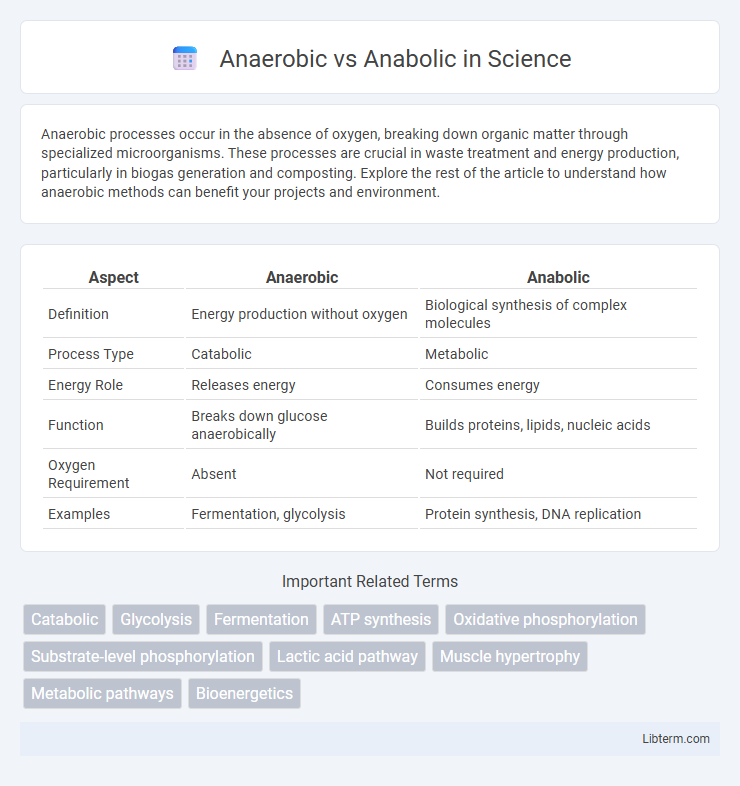Anaerobic processes occur in the absence of oxygen, breaking down organic matter through specialized microorganisms. These processes are crucial in waste treatment and energy production, particularly in biogas generation and composting. Explore the rest of the article to understand how anaerobic methods can benefit your projects and environment.
Table of Comparison
| Aspect | Anaerobic | Anabolic |
|---|---|---|
| Definition | Energy production without oxygen | Biological synthesis of complex molecules |
| Process Type | Catabolic | Metabolic |
| Energy Role | Releases energy | Consumes energy |
| Function | Breaks down glucose anaerobically | Builds proteins, lipids, nucleic acids |
| Oxygen Requirement | Absent | Not required |
| Examples | Fermentation, glycolysis | Protein synthesis, DNA replication |
Understanding Anaerobic and Anabolic Processes
Anaerobic processes occur without oxygen, primarily generating energy through glycolysis, which produces ATP quickly but less efficiently compared to aerobic respiration. In contrast, anabolic processes involve the synthesis of complex molecules from simpler ones, requiring energy input to build proteins, nucleic acids, and other macromolecules essential for cell growth and repair. Understanding the interplay between anaerobic energy production and anabolic biosynthesis is crucial for optimizing muscle growth, recovery, and metabolic function.
Key Differences: Anaerobic vs Anabolic
Anaerobic processes occur without oxygen, involving energy production through glycolysis, while anabolic processes focus on building complex molecules from simpler ones, requiring energy input. Anaerobic metabolism generates ATP quickly but produces byproducts like lactic acid, whereas anabolic pathways consume ATP to synthesize proteins, lipids, and nucleic acids. The key difference lies in their metabolic objectives: anaerobic pathways provide rapid energy under oxygen-limited conditions, whereas anabolic pathways support cellular growth and repair through biosynthesis.
The Science Behind Anaerobic Metabolism
Anaerobic metabolism occurs in the absence of oxygen, breaking down glucose into energy through glycolysis to rapidly produce ATP, primarily during high-intensity exercise. This process results in the accumulation of lactic acid, which can cause muscle fatigue but allows continued energy production when oxygen supply is limited. Unlike anabolic metabolism, which focuses on building molecules and storing energy, anaerobic metabolism prioritizes immediate energy release for short bursts of intense physical activity.
Anabolic Pathways: Building Blocks of Growth
Anabolic pathways drive growth by synthesizing essential biomolecules such as proteins, nucleic acids, and lipids from smaller precursors through energy-consuming reactions. These pathways utilize ATP and reducing agents like NADPH to assemble macromolecules vital for cell repair, replication, and overall development. Unlike anaerobic processes that focus on energy extraction without oxygen, anabolic processes are primarily constructive, enabling organismal growth and tissue formation.
Energy Production: Anaerobic vs Anabolic Systems
Anaerobic energy production relies on the breakdown of glucose without oxygen, rapidly generating ATP through glycolysis and producing lactic acid as a byproduct. The anabolic system, in contrast, consumes ATP to synthesize complex molecules like proteins and nucleic acids, supporting cellular growth and repair. While anaerobic pathways provide quick bursts of energy for short-term, high-intensity activities, anabolic processes are energy-dependent and essential for long-term metabolic maintenance and development.
Role in Exercise and Physical Performance
Anaerobic exercise relies on energy produced without oxygen, primarily through glycolysis, supporting short bursts of high-intensity activities like sprinting and weightlifting. Anabolic processes involve the synthesis of complex molecules, promoting muscle hypertrophy and recovery essential for improving strength and endurance. Effective physical performance combines anaerobic energy production with anabolic muscle repair to enhance power, speed, and overall athletic capacity.
Muscle Growth: Anabolic Advantages
Anabolic processes play a crucial role in muscle growth by promoting protein synthesis and tissue repair, which are essential for hypertrophy. Unlike anaerobic activities that primarily focus on energy production without oxygen, anabolic pathways facilitate recovery and muscle fiber regeneration after intense workouts. Enhanced anabolic signaling through hormones like testosterone and insulin-like growth factor 1 (IGF-1) significantly accelerates muscle mass development and strength gains.
Lactic Acid and Anaerobic Fatigue
Anaerobic metabolism primarily generates energy through lactic acid fermentation, leading to lactic acid accumulation in muscles, which contributes to anaerobic fatigue. This metabolic pathway operates without oxygen, causing hydrogen ion buildup and muscle pH reduction, impairing enzyme activity and muscle contraction. In contrast, anabolic processes focus on muscle repair and growth by synthesizing proteins from amino acids, helping to recover from fatigue and improve muscle endurance.
Nutrition for Anaerobic and Anabolic Support
Nutrition for anaerobic support emphasizes high-intensity energy sources like creatine, simple carbohydrates, and branched-chain amino acids (BCAAs) to rapidly replenish ATP and enhance muscle power during short bursts of activity. For anabolic support, nutrition prioritizes adequate protein intake, essential fatty acids, and micronutrients such as zinc and vitamin D to stimulate muscle protein synthesis, hormone regulation, and tissue repair. Combining carbohydrates with protein post-exercise maximizes glycogen recovery and muscle growth, optimizing overall performance and recovery in both anaerobic and anabolic phases.
Practical Applications in Fitness and Health
Anaerobic exercise, characterized by short bursts of high-intensity activity like weightlifting and sprinting, primarily enhances muscle strength and power by utilizing energy sources without oxygen. Anabolic processes in fitness involve muscle growth and repair through protein synthesis, stimulated by resistance training and adequate nutrition. Combining anaerobic workouts with anabolic nutritional strategies optimizes muscle hypertrophy, improves metabolic rate, and supports overall physical performance and recovery.
Anaerobic Infographic

 libterm.com
libterm.com